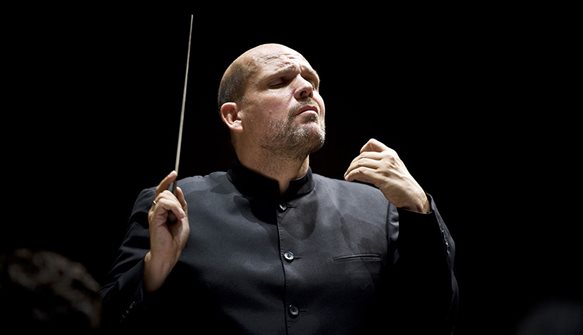
Bruckner Symphonies: Avoid the Wheezes
Performances of Bruckner symphonies can get reactions ranging from whee to a wheeze. The current stab at Bruckner’s Fifth certainly elicits no whee of delight—Z-z-z-z’s more than whee’s—-but the concert by the S.F. Symphony fortunately offered a first-rate Mozart Clarinet Concerto by way of compensation.
As the Mozart soloist, Carey Bell made a strong case for being placed in the league of the top actives in clarinet like New Yorker Anthony McGill. His arpeggios are like waterfalls, his legatos are velvet-smooth, his pitch unerring and the pianissimos breath-taking. He immerses his whole frame into the music, swaying sinuously with bended knee, even rotating hips in slow motion—the body English echoes his music which means, given his great height, an awful lot of English. As principal of the SFS clarinet section, his compelling tone had been inescapable before. But as concerto soloist, his prowess glowed at Davies Hall Jan. 11 in unique fashion.
We owe the existence of this highly idiomatic late-life concerto to Mozart having met a very good player, Anton Stadler. (If only he’d also met a prime cellist and produced at least one cello concerto!). Nowhere did Mozart achieve a closer union of soloist with orchestra than here—he even forewent the near-obligatory cadenza (an unaccompanied, quasi-improvisatory solo display passage). His one misjudgment was writing for a (now extinct) basset clarinet, calling for notes lower than those a clarinet can offer.
I hear this work, or its close Mozart companion, the irresistible Clarinet Quintet, and inevitably however glum the mood, I emerge with joy—hardly what you’d expect from a composer only a month away from his demise. The exuberance is built structurally into the two outer movements, with the intervening slow movement providing meditation.
As for Bruckner, whose sound was greatly influenced by Richard Wagner: the Fifth is a perennial problem, and not even the new music director of the N.Y. Philharmonic, the guest Jaap van Zweden, could breathe life into this ponderous, repetitive, 75-minute lummox written in 1875-78. The work reminds you of your cedar tree having too many branches, crying out for judicious trimming in order to approach optimum health.
It’s understandable that early maestros edited or trimmed most of Bruckner’s output, particularly since no composer of note had written such long symphonies. Even Beethoven’s Ninth had been substantially shorter. The ultimate result was multiple publications of the symphonies, with perennial uncertainty as to what was Bruckner’s own, unadulterated work. The best-known editions are the Haas (as used here), the Nowak, and the critical edition called the Bruckner–Gesamtausgabe.
Fascinating even in some of the least successful Bruckner symphonies is the unmistakable hand of Bruckner the dedicated organist. In abrupt shifts from the intimate to the exploding brass chorales, he was in effect changing registers or stops just as at the pipe organ he loved so much. The sudden turns from pianissimo to fortissimo and back again permeate the Fifth as much as any of them.
And the glory of Bruckner’s voluptuous orchestration is the earth-shaking and richly harmonious brass, here produced by 13 virtuoso players. One of them, overheard on the sidewalk afterward and headed home, quipped, “Could you hear us all right?”
Van Zweden was the no-nonsense, plow-on-ahead conductor, with a style and look reminding one of Erich Leinsdorf, who had led the Boston Symphony a half-century ago. But not even van Zweden could make this opus sing with vitality.
If Bruckner produces just the sort of symphony you’d want to curl up with, let me recommend the Seventh and the “Romantic” (No. 4), with No. 8 and the unfinished No. 9 meriting almost equal mention. If heavenly length is your thing, No. 8 runs close to 90 minutes.
S.F. Symphony under podium guest Jaap van Zweden in Bruckner and Mozart, through Jan. 13. Davies Hall, S.F. For info: (415) 864-6000, or go online.